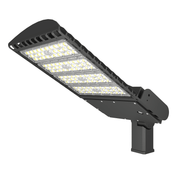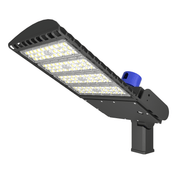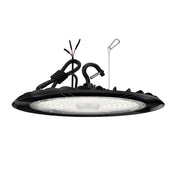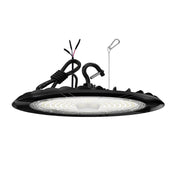1. Technological breakthroughs: the core advantages of LED area lights
Energy efficiency revolution and long-term stability
LED area lights use the third-generation semiconductor light source technology, which is more than 5 times more efficient than traditional lamps and has a working life of up to 50,000 hours, greatly reducing maintenance frequency and energy consumption costs.
Through the intelligent constant current driver chip and thermal simulation optimization design, the lamp can operate stably in an environment of -30℃ to 50℃, and the heat dissipation efficiency is increased by 30%, avoiding the problem of light decay.
Precise light control and scene adaptation
Integrated PWM dimming technology and multi-channel mixing algorithm support stepless adjustment of the 3000K-6000K color temperature to meet the differentiated needs of offices, commercial, industrial, and other scenes.
The photosensitive sensor and human body sensing module can automatically sense the ambient brightness and personnel activities, realize "on-demand lighting", and the comprehensive power saving rate exceeds 60%.
Modular design upgrade
Adopting a honeycomb optical lens and replaceable light panel structure, the beam angle covers 15° to 120°, supports quick disassembly and maintenance, and is suitable for ceiling embedding, hoisting, track installation, and other methods.
2. Application scenarios: from functional lighting to spatial aesthetics
Commercial space lighting
In shopping malls, exhibition halls, and other places, LED area lights accurately present the color details of goods through uniform lighting and high color rendering index (Ra>90) characteristics, enhancing consumers' visual experience12.
Combined with the intelligent control system, it can link the building management system (BMS) to achieve zoned and timed lighting, reducing operating costs34.
Industry and public facilities
In high-ceiling scenes such as warehouses and workshops, LED area lights equipped with anti-glare grilles can provide flicker-free lighting, reduce visual fatigue, and reduce the accident rate by 18%.
The solar-powered version uses MPPT maximum power tracking technology to achieve 24-hour off-grid lighting in areas without power grids, suitable for scenes such as roads and parking lots.
Home and Education Space
LED area lights with a blue light hazard-free design, combined with diffuse reflection light sources, have become the first choice for classrooms and study rooms, and their eye protection effect has passed the IEC/EN 62471 photobiological safety certification.
3. Future Trends: From Single Lamp to Light Environment Ecosystem
Deep Integration of the Internet of Things
The new generation of LED area lights has a built-in Wi-Fi/Bluetooth dual-mode communication module, which supports seamless connection with smart home platforms (such as HomeKit, Tuya), and users can remotely control via voice or APP34.
Breakthrough in Flexible Optical Materials
Based on nanoscale light guide plates and quantum dot coating technology, the thickness of the lamp can be compressed to less than 12mm, while achieving 98% light efficiency utilization, providing the possibility for ultra-thin embedded design.
Light Environment Customization Service
Through spectral programmable technology, lamps can simulate the circadian rhythm of natural light or release specific wavelengths of light (such as 450nm blue light and 660nm red light required for plant growth), expanding to the fields of agriculture and medicine.
Conclusion
LED area lights are evolving from "basic lighting tools" to "space light environment managers", and their technological iterations have always revolved around the three core elements of energy saving, intelligence, and humanization. With the continuous breakthroughs in third-generation semiconductor materials and AIoT technology, LED area lights will be deeply integrated into smart cities and green building systems in the future, redefining the way people interact with light.








